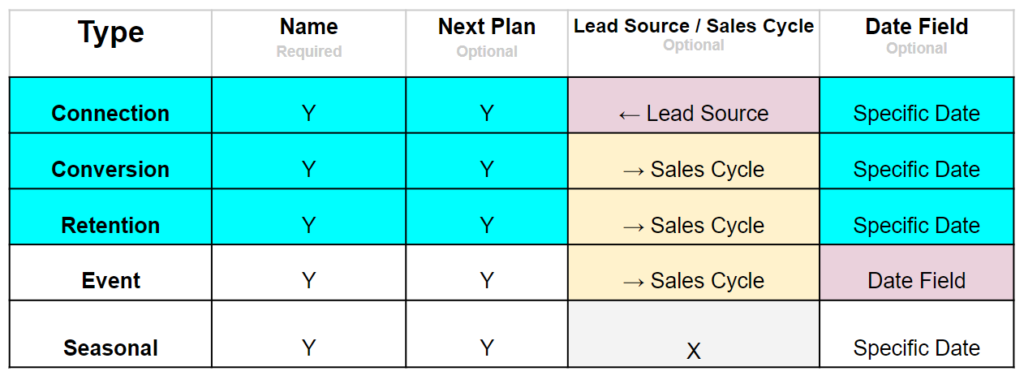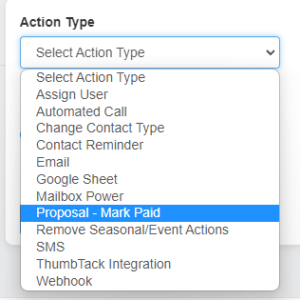Action Plans
February 10, 2020Overview
Action plans are personalized, automated communication sequences that support Lead engagement via phone, SMS, email, and physical media fulfillment that are central to the purpose and value of this system.
Action Plans allow a user to create personal, yet automated engagements to ensure immediate Lead follow up, provide ongoing client sales communications, and support retention and outreach efforts as well as online reputation management after a sale.
These Action Plans are broken down into different types to help you utilize them more effectively.
- Connection Plans
- Conversion Plans
- Retention Plans
- Events Plans
- Seasonal Plans
From the Action Plan menu, you also have access to templates, your email signature, and the ability to export your action plans for review.
Locked Action Plans shared from Enterprise Account to Sub-accounts
When “locked” Action Plans are shared to Sub-accounts from the Enterprise level, Sub-Account users can view the content of Action Plans via the magnifying glass button () shown to the right of the plan name displayed within that Action Plan menu. Please note that this “view-only” option does not open the Action Plan for editing purposes. Instead, the plan is displayed in “read only” mode. To view the content of each step within that Action Plan, the Sub-account user should click on the step name under the step number at the far left when the Action Plan is displayed.

Topics
- Creating Action Plans
- Actions Available
- How to Add an Action
- Differences in Types of Action Plans
- Templates
Creating Action Plans
No matter the type of action plan the creation is very similair.
- Click on the
 by the Add New
by the Add New - Enter The Action Plan Name
- Leave your new Action Plan in Draft Mode until it is Ready for use.
- Select Next Plan if you would like to launch another Action Plan after this plan has run its full course.
- Then, you may choose a Lead source or Sales Cycle depending on the type of Action Plan (see colored table above). The lead Source selected in a Connection Plan will ensure that each lead from that source immediately is engaged by that Action Plan. A Sales Cycle selected in a Conversion or Retention plan will automatically set that Contact’s Sales Cycle when the Action Plan is activated.
- Also depending on the plan you may be able to add a specific date for the plan.
- When have finished please click

- After you have added all the necessary steps to your Action Plan, be sure and change from Draft mode to Ready using the switch just above the Action Plan’s name.
Actions Available
The following overview provides information on the standard Action Plan steps available.
- Assign User
- Allows you to assign an account user to work directly with the contact
- Also allows user to be unassigned from contact
- Automated Call
- Allows you to schedule a call so you can speak with the contact at a scheduled interval
- Change Contact Type
- Changes Contact Type from one to another. The standard Contact Type names are: Clients, Employees, Partners, Vendors, Other, You have the ability to rename these defaults.
- Contact Reminder
- Reminds you to contact a contact on a set day.
- Email
- Allows you to pre-write and set specific emails that need to be sent at set times to contacts.
- SMS
- Allows you to pre-write and set specific texts that need to be sent at set times to contacts.
Additional Action Plan Steps based on Add-ons enabled in Settings:

Additional Action Plan Steps are shown at the drop-down Action Type menu.
These specific steps are based on the use of enabled features and add-ons that can be found within the Settings menu at Add-Ons.
In this image, we have highlighted the Proposal-related feature that allows for an Action Plan step to indicate a Proposal Invoice has been paid. Adding this step to the plan directly relates to the use of the Proposal System within the account.
Webhooks
You can add a Webhook, API call, to an Action Plan:
This type of step requires the same settings to be established:
- Assign step name
- Designate if you want a notification
- Select immediate or delayed
You will need to fill out the information for the URL and Header based on the documentation for the software you are using the Webhook to connect to.
You have the option to Get (retrieve), POST or PUT (send) information via the Webhooks.
For the payload, usually only used with POST and PUT, you can toggle to send all information about a client. However, it is usually preferred to only send the information you need.
Use the Key Name and Value fields to designate what information is being sent. For the value field you can either enter something that is always sent such as the number 5 or you can use Tokens to send information unique to the Contact in the Action Plan.
Two things to keep in mind:
- We only send flat data from ClientTether NOT nested
- You are responsible for being familair with the required information needed to connect to the software you are trying to Webhook into.
For an example of a built Webhook please refer to our Zapier Documentation on sending a webhook to a Zap.
Webhook Monitor
Under the Hello {Your Name} Main Menu there is a Webhook Monitor.
This is used to display information on failed webhook attempts.
When an Action Plan sends data to another system, Users are often blind to the fact. If the action is successful, no one cares. But if the action fails the system has a duty to report that.
1. a system Notification is generated to inform users.
2. the failed attempt is also captured in a History Note
3. the failed attempt is also captured in the Webhook monitor with details that could help diagnose why the send failed.

Building or Editing your Action Plans
Getting Started
From the center of the Action Plan menu, you can see the options for building a new step. To build or add a step to your plan, complete the following steps:
- Select the Action Type (what will this step do)
- Name the Action–you’ll see this name at the list on the left.
- Select if you would like a notification on the action
- Select the timing of the Action as follows:
- Immediate steps will be sent as soon as the Contact is launched on the Plan.
- Delayed steps will be delayed from the time Action plan is launched and will occur as indicated in their menu.
- A note on timing: If multiple steps are added to the Action Plan, and are in the same timing realm – immediate or delayed by 1 minute – the steps will fire in the order displayed in the plan. To change the order you can delete or add steps accordingly until the immediate steps are in the preferred order.
- If a specific date is set for the Action Plan, the following applies:
- Immediate Action Plan steps will be sent out the as soon as the plan is launched for that Contact.
- Before timed Action Plan steps will launch at the designated time before the event (an appointment, for example).
- If someone is added to an action plan outside of the allotted time for an action, the action will be skipped.
- If an action is set to 3 days before an event and you put someone in the action plan 1 day before the event the action will be skipped.
- Delayed timed Action Plan steps will launch as assigned, after the event date/time as indicated in the setup of that step.
- Click

Differences in Types of Action Plans
Connection Plans – These plans are designed to help establish initial connection with new leads, which is why they typically have a Lead Source attached to them.
Connection Plans are typically short term plans, designed to run less then a month and can flow automatically to a Retention Plan if the Lead does not respond to Connection Plan communications.
Conversion Plans – These plans are intended to assist with moving current Leads/Contacts forward in your Sales Cycle/ and business process.
Conversion Plans are designed to typically run 1-3 months and can flow to a Retention Plan if engagement is lost during the sales process.
Retention Plans – These plans are designed to maintain relationships with current, past, and lost customers.
Retention Plans should nurture a lead for 6-months to a year via less aggressive engagement communications (emails, SMS, Contact Reminders, etc.) that are scheduled over a longer-time frame in comparison to other plan types.
Events Plan – Events plans are designed to work around a specific date/Event. This can include an appointment or follow-up, as well as for promotion for an upcoming event, etc.
Please note: If you delete the “Event” for that Lead, any remaining Event Plan steps will also be deleted from Upcoming Actions within the Contact Profile for that Lead.
Seasonal Plans – Seasonal Plans are designed to work around a specific date/Event. This can include appointments, conferences, promos, etc. This type of plan is also designed to work with groups.